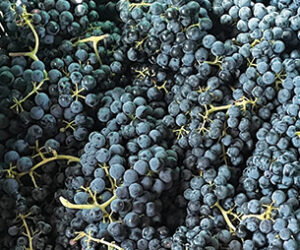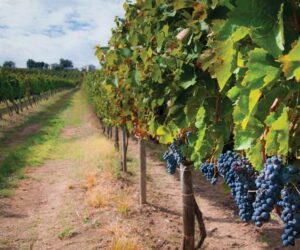
As an avid winemaker I have made ports many times and I actually grow a higher acid grape in my vineyard for just this purpose. Several years ago, after giving away most of my reserve stock that was several years old (and of course consuming my own share), I found that my cellar was becoming quite empty. It was mid winter and would be quite some time before I could think of picking any grapes, so I began thinking of what fruits might be available locally that I could experiment with in making a fortified wine.
Mind you I didn’t go into this blind. I had tasted a fortified wine called Framboise, vinted by Bonnie Doon Vineyards. I thought this wine was simply fantastic and ended up drinking the entire half bottle all to myself as I bounced about happily. At the time I had a good source through an affiliate for pure raspberry juice and so my venture to create a fruit port style wine was under way.

Fruit or juice that is high in sugar content will be desirable. For lower sugar juices, sugar may be added to achieve an adequate level of sugar in the must. Acid levels must also be sufficient to support the finished sugar content and dilution of the base wine.
- Use a strong yeast and get a good starter going before inoculating, this is due to the high sugar environment and to ensure a healthy colonization in the must.
- Monitor fermentation closely, keeping the must cool for added fruitiness. When the sugar level drops to the desired level — generally between 6 and 10 °Brix — stop fermentation by adding brandy or another high-alcohol beverage.
- Clear and age your port wine.
Enter Everclear
One main difference between a grape port and a fruit port is the fortifying agent. Most ports made from grapes are fortified with brandy, which is typically 80 proof (40% alcohol). For your fruit port, you will use a grain alcohol known as Everclear. Everclear is a grain alcohol sold in 190 proof and 151 proof versions. The 190 proof version contains 95% ethanol by volume; the 151 proof version is 75.5%. (In any alcoholic beverage, proof is twice the alcohol percentage.) Because of its high alcoholic strength, it is illegal to purchase in some U.S. states. Vodka (80 proof, 40% alcohol) can also be used, but you will need to add much more of it given its lower alcoholic strength compared to Everclear. Although high alcohol rums — Bacardi 151 proof rum, for example — are available, you should not use them as they will add the flavor of rum to your fruit port.

Other options
It’s worth noting that some wineries may make a fruit wine and then distill this wine to get a very flavorful fortifying agent to add to their fermenting ports to stop the fermentation. (Bonny Doon’s Framboise — according to its label — is fortified with “grape neutral spirits.”) Of course distillation is illegal for most of us, so we will have to stick with adding the spirits we can purchase.
Ports will vary in alcohol content, but I generally like to shoot for a level between 18 and 20% alcohol. The result will be a sweet, high-alcohol wine that is simply a wonderful sipping beverage and certainly fairs well in the local cigar bar. A well-made fruit port’s flavor comes almost entirely from the base wine. As such, it displays fresh fruit flavor backed up by a substantial amount of sweetness.
Fruit Wine as a Base

Plan for the Dilution
As the wine is going to be diluted with the fortifying agent, the acidity and fruit flavors will be diminished somewhat. You should compensate for this by adding proportionally more fruit and increasing the acidity of your base wine.
If you plan on using 151 proof Everclear, use at least 24% more fruit (if possible) and shoot for an acidity level 24% higher than the standard target for that style of fruit wine; shoot for 18% more fruit and acidity if you will be using 190 proof Everclear. From a procedural standpoint, you should also plan ahead and ferment in a container with enough extra volume to accept the fortification dosage.
Monitor your fermentation carefully and be prepared to stop it when your hydrometer reads 10 °Brix (a specific gravity of 1.040). If your must initially measured 22.5 °Brix (SG 1.090), you will now have a sweet wine with 6.5% alcohol.
Stop, in the Name of Port
Adding alcohol will stop the fermentation of your base fruit wine, leaving the unfermented sugars to sweeten your fruit port. If you are using 151 proof Everclear, add 1.2 gallons (4.5 L) of it to your 5-gallon batch of fruit wine. For 190 proof Everclear, add 0.9 gallons (3.4 L). (If you use vodka, you will need to add 3.3 gallons (12.5 L) to your 5-gallon (19-L) batch!)
This alcohol addition will yield a fruit port with 20% alcohol. Stir well so the alcohol mixes rather than floats on top of the wine. A common tool used to figure out the amount of alcohol to add (regardless of proof) to hit any target alcohol level in a port-style wine is the Pearson square. For a complete explanation of the Pearson square, see Daniel Pambianchi’s article “Luscious Port Wine” in the December 2002-January 2003 issue of WineMaker. Knowing how to use this mathematical tool will help any winemaker formulate their own fortified wines.
Stabilization
Alcohol will stop any active fermentation and stabilize the wine. You may wish to add up to 25 ppm sulfur dioxide (SO2), from potassium metabisulfite powder or Campden tablets, but this is not strictly necessary. You should not add any sorbate — as is common in fruit wine production — to stabilize the wine.
Quick Aging, Small Bottles
Once your fruit port is blended, let it age for four to six months. Rack every two months to separate the wine from the lees. Adding a small amount of metabisulfite to maintain a preventative level of SO2 is an option. You probably won’t need any fining agents as the alcohol should help the wine clear on its own.
You will likely want to bottle your fruit port in traditional port bottles or other 375 mL bottles. Many ports — and port-style wines — are closed with a short cork with a plastic stopper. These closures must be inserted by hand. Fruit wines are usually quick-aging wines, meant to be drunk young. With the added alcohol, however, fruit ports have the potential to age for a few years.




